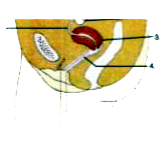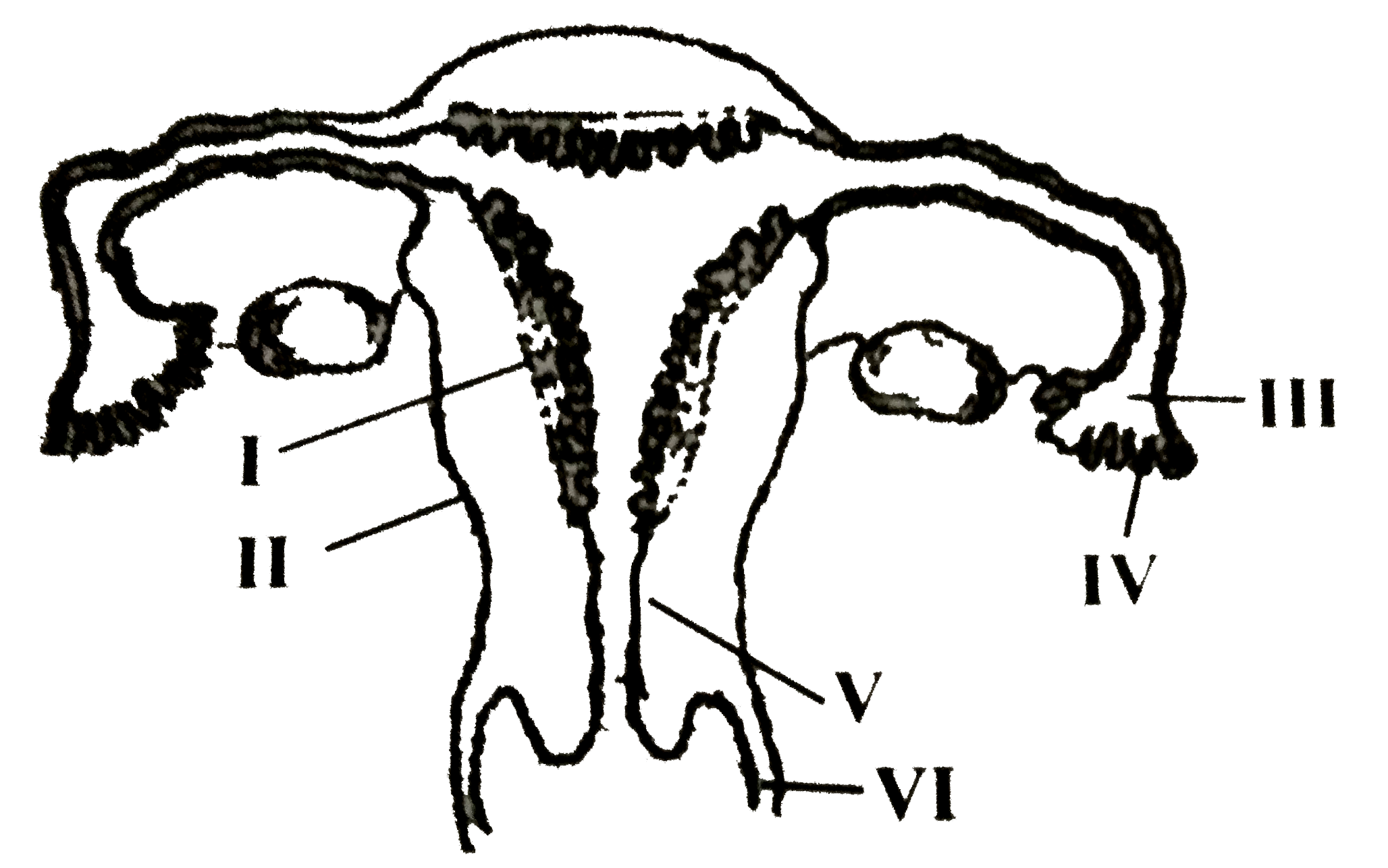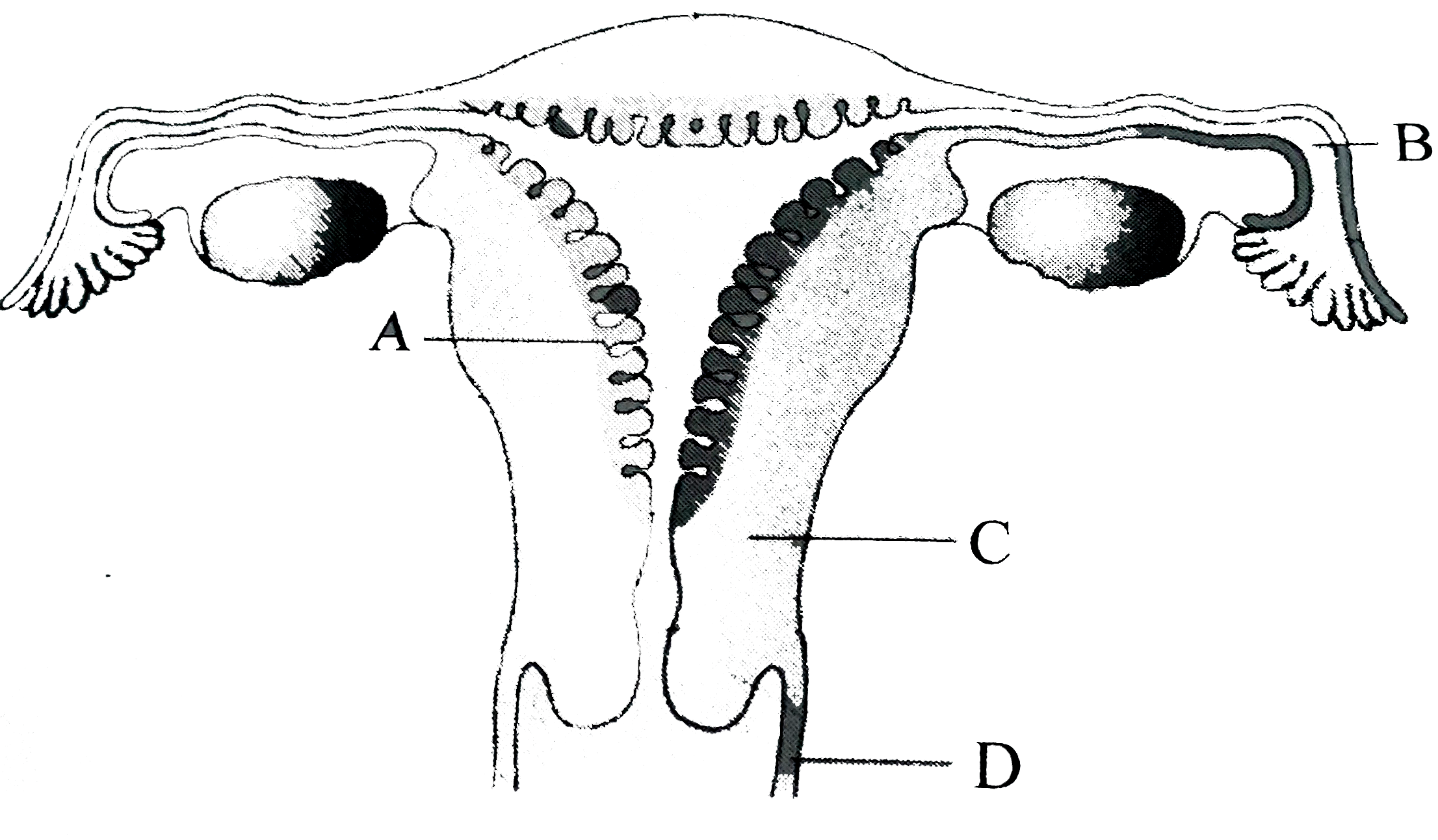(a) Draw a diagrammatic sectional view of the female reproductive system of human and label the parts
(i) where the secondary oocytes develop
(ii) which helps in collection of ovum after ovulation
(iii) where fertilization occurs
(iv) where implantation of embryo occurs.
(b) Explain the role of pituitary and the ovarian hormones in menstrual cycle in human females.
Step-by-Step Solution
1. Draw the Outline of the Female Reproductive System: Start by sketching a vertical section of the female reproductive system, which includes the uterus, ovaries, fallopian tubes, and vagina.
2. Label the Ovaries: At the top of the diagram, draw two oval shapes on either side to represent the ovaries. This is where the secondary oocytes develop.
3. Draw the Fallopian Tubes: From each ovary, draw a tube that curves towards the uterus. These tubes should have a funnel-like structure at the end (fimbriae) that helps collect the ovum after ovulation.
4. Indicate the Uterus: Below the fallopian tubes, draw a pear-shaped structure to represent the uterus. This is where the implantation of the embryo occurs.
5. Label the Endometrium: Inside the uterus, label the inner lining as the endometrium, which is crucial for implantation.
6. Indicate the Site of Fertilization: Mark the junction between the isthmus and ampulla of the fallopian tubes as the site where fertilization occurs.
7. Label the Myometrium and Perimetrium: Outside the endometrium, label the muscular layer as the myometrium and the outer layer as the perimetrium.
(b) Role of Pituitary and Ovarian Hormones in the Menstrual Cycle
1. Pituitary Hormones: The pituitary gland releases two main hormones during the menstrual cycle:
- Follicle Stimulating Hormone (FSH): This hormone stimulates the growth of primary oocytes into secondary oocytes in the ovaries.
- Luteinizing Hormone (LH): This hormone induces ovulation, which is the release of the secondary oocyte from the ovary.
2. Ovarian Hormones: The ovaries produce two key hormones:
- Estrogen: This hormone promotes the proliferation of the endometrium (the uterine lining) in preparation for potential implantation of a fertilized egg.
- Progesterone: This hormone maintains the endometrium for implantation and supports the early stages of pregnancy if fertilization occurs.
- Follicle Stimulating Hormone (FSH): This hormone stimulates the growth of primary oocytes into secondary oocytes in the ovaries.
- Luteinizing Hormone (LH): This hormone induces ovulation, which is the release of the secondary oocyte from the ovary.
- Estrogen: This hormone promotes the proliferation of the endometrium (the uterine lining) in preparation for potential implantation of a fertilized egg.
- Progesterone: This hormone maintains the endometrium for implantation and supports the early stages of pregnancy if fertilization occurs.
Topper's Solved these Questions
- REPRODUCTIONBook:TRUEMEN BIOLOGY ENGLISHChapter:REPRODUCTIONExercise:SECTION -C
Explore 22 Videos
- Protista Book:TRUEMEN BIOLOGY ENGLISHChapter:Protista Exercise:ASSERTION AND REASON
Explore 6 Videos
- Reproduction In OrganismsBook:TRUEMEN BIOLOGY ENGLISHChapter:Reproduction In OrganismsExercise:MULTIPLE CHOICE QUESTION
Explore 131 Videos
Similar Questions
(a) Draw a diagram of the adult human female reproductive system and label the different :
(i) parts of fallopian tube (ii) layers of uterus wall
(b) Explain the events during fertilization of an ovum in humans.
View SolutionGiven here is a section of the female reproductive system in humans.
a. Name the parts labelled 1 to 4
b. Name the part where fertilisation occurs in the female reproductive system.
View Solution
Knowledge Check
The given figure depicts a diagrammatic sectional view of the human female reproductive system. Which set of three parts out of I−Vi have been correctly identified?
 A(II) endometrium, (III) infundibulum, (IV) fimbriaeB(III) infundibulum, (IV) fimbriae, (V) cervixC(IV) oviducal funnel, (V)uterus,(VI)cervixD(I) perimetrium, (II) myometrium, (III) Fallopian tube
A(II) endometrium, (III) infundibulum, (IV) fimbriaeB(III) infundibulum, (IV) fimbriae, (V) cervixC(IV) oviducal funnel, (V)uterus,(VI)cervixD(I) perimetrium, (II) myometrium, (III) Fallopian tube
(a) Draw a labelled diagram of the human female reproductive system.
(b) Enumerate the events in the ovary of a human female during
(i) Follicular phase
(ii) Luteal phase of menstrual cycle.
View SolutionThe given diagram shows a human female 's reproductive system. Select the part (labelled as A, B, C & D) where semen is released into the female by the penis during copulation

View Solution(a) Draw a diagrammatic sectional view of a mature anatropous ovule and label the following parts in it :
(i) that develops into seed coat.
(ii) that develops into an embryo after fertilization.
(iii) that develops into an endosperm in an albuminous seed.
(iv) through which the pollen tube gains entry into the embryo sac.
(v) that attaches the ovule to the placenta.
(b) Describe the characteristic features of wind pollinated flowers.
View Solution(a) Draw a diagrammatic sectional view of a mature anatropous ovule and label the following parts in it :
(i) that develops into seed coat.
(ii) that develops into an embryo after fertilization.
(iii) that develops into an endosperm in an albuminous seed.
(iv) through which the pollen tube gains entry into the embryo sac.
(v) that attaches the ovule to the placenta.
(b) Describe the characteristic features of wind pollinated flowers.
View Solution(a) Draw a diagrammatic sectional view of a seminiferous tubule (enlarged) of human male and label (i) Spermatogenium, (ii) Sertoli cell, (iii) Primary spermatocyte. Write the function of each labelled part.
(b) Differentiate between spermatogenesis and spermiogenesis.
View SolutionExplain the ovarian and uterine events that occur during a menstrual cycle in a human female, under the influence of Pituitary and Ovarian hormones respectively.
View Solution(a) In which part of the human female reproductive system do the following events take place?
(i) Release of 1st polar body
(ii) Release of 2nd polar body
(iii) Fertilisation
(iv) Implantation
(b) From where do signals for parturition originate and what does maternal pituitary release for stimulating uterine contractions for childbirth?
View Solution